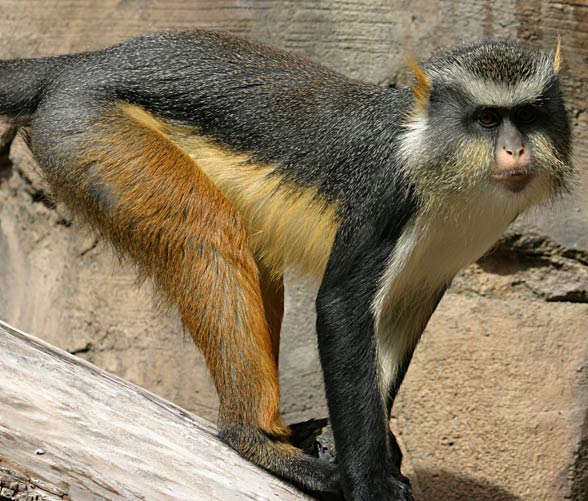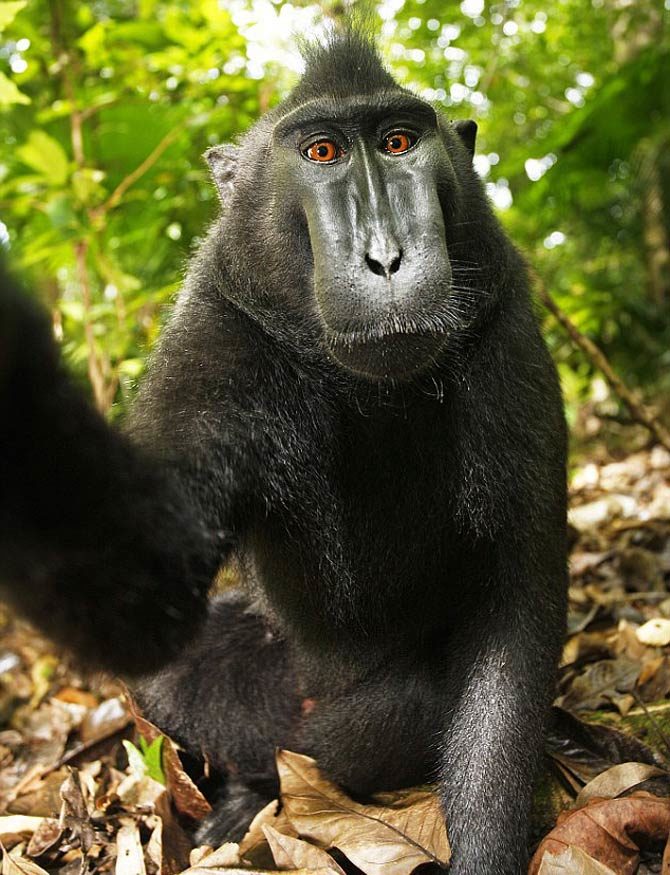Guenons (Cercopithecus)
Guenons are like parrots among the primates, and all through an amazing variety of colors, patterns and … faces. Each species has unique features, highlighted by geometric patterns, most visible on the nose. Why did nature give guenons this unique feature? Guenons can also make a funny selfie, which you can see in the gallery at the end of the article 🙂
Classification
- Kingdom: Animalia
- Class: Mammalia
- Order: Primates
- Family: Cercopithecidae
- Genus: Cercopithecus
The genus Cercopithecus consists of about 26-28 species of guenons.

Occurrence
Guenons are African endemic animals. They occur in sub-Saharan regions. Although most of them prefer jungles and bamboo forests, there are also amateurs of wetlands and mountain rainforests. They usually lead an arboreal life, however, many species are endangered by deforestation.

Characteristic
Appearance
Guenons are famous for their beautiful, soft fur, which they owe to their coloration – each hair is alternated in two colors. Guenons may have rainbow coloration: red, gray, brown, yellow and even green. Why are there so many variations in the shape of the muzzle and the coloration? It is probably in order to help identify individuals of different species and to prevent inter-species breeding. Thanks to that, hybridization does not occur, which can lead to the extinction of genetically pure animals. Nevertheless, in some regions of Africa, the red-tailed monkeys (Cercopithecus ascanius) crossbreed with the blue monkey Cercopithecus mitis.
The body is slim, supported by four long limbs. The head is proportional to the body, the muzzle is short, just like in the case of the macaques. In addition to coloration, a long, yet unobtrusive tail helps to maintain balance when moving around the trees. It reaches a length greater than the whole body together with the head.
These monkeys have on average 42 – 56 cm (16.5 – 22 in) in height (without tail); males are heavier than females – they weigh more than 7 kg (15.4 lb), while females do not exceed 5 kg (11 lb). The smallest species reach only 2.5 kg (5.5 lb).

Lifestyle
Most of the guenons live in large, territorial groups compound of females, their offspring, and one adult male. In order to maintain a sufficient distance between the groups, the males bark loudly. However, while searching for food, many strange groups meet in one place. Those monkeys eat fruit, leaves, sometimes insects or small vertebrates.
The reproductive season does not occur within the specified time frame, these monkeys can reproduce throughout the year. Depending on the species, the pregnancy lasts 5 – 7 months, after which one juvenile is born. In the case of some species, multiple pregnancies occur as well.

On the following pages, we present the characteristics of selected species. We present the smallest, the largest and the fastest guenon.
Characteristics of selected species of guenons
The patas monkey (Erythrocebus patas) – the largest guenon
Occurrence
One of a few species living on the ground. It lives in deserts and semi-desert areas, avoiding dense forests. It has been noted that patas reproduces very early, which is probably due to the large adult mortality resulting from the life on the ground.
Size
Patas reaches 85 cm (33.5 in) in length, excluding a tail measuring up to 75 cm (29.5 in). These monkeys are also the heaviest among all the species, weighing 4 – 13 kg (8.8 – 28.7 lb). Adult males are much larger than females. This does not change the fact that adult females are in charge of a herd the leader of which is a male.

Coloration
The specimens of this species are intensely colored; on the top of the head grows red hair, the face is round light, long, light hair, creating a kind of beard. The back also has shades of red, but the bottom of the body takes on cream or whitish colors. We can see dark gray fur on the shoulders, cheeks and eyebrows.
Family life
The patas monkey lives in groups of about 60 individuals, although there are often much larger communities. In each such group, apart from the breeding season, there is only one male, it changes with the beginning of mating, when more male animals can join the herd for a certain time.
In about 4 years of age, male offspring have to leave the family, joining so-called bachelor groups.

Talapoin (Miopithecus talapoin) – the smallest species
Occurrence
It lives in coastal areas of Angola, southern Cameroon and the Democratic Republic of Congo. It chooses mangrove forests, lowland jungles, and estuaries for its habitats. In contrast to its light-skinned cousin the Gabon talapoin (Miopithecus ogouensis), the talapoin from Angola has blackish ears, skin, and nostrils. The upper part of the body is covered with greenish-yellow hair, while the chest and belly have a lighter color.
Size
The body length is 26 – 45 cm (10.2 – 17.7 in), while the weight ranges from 0.75 to 1.3 kg (1.65 – 2.9 lb). Males are always bigger and heavier than females.

Lifestyle
It leads the arboreal life. It is active during the day, and in the evening it hides in the thick plants, in the lower parts of the trees where the monkeys sleep in small groups of 3 – 4 individuals. It is one of the quietest species of monkeys – it emits only sharp whistles (as a warning signal). It feeds on fruits, seeds, insects and small vertebrates.
Contrary to most primates, talapoin swim in swamps and can also fully submerge underwater for food.
These monkeys form groups of about 100 individuals, including several males. However, they usually live in family groups, which consist of over a dozen individuals.
Talapoin mate only during the dry season, the pregnancy lasts 5-6 months.

The fastest primate – the patas monkey
The patas monkey (Erythrocebus patas) is the fastest runner among the primates. It can develop a speed of up to 55 km / h. It is, of course, the fastest guenon. Interestingly, it can move on two limbs, supporting on its tail.
Detailed data and dimensions
Guenons (Cercopithecus)
- Body length (without tail): 26 – 75 cm (10.2 – 29.5 in)
- Tail length: 31 – 100 cm (12.2 – 39.4 in)
- Weight: 0.75 – 13 kg (1.65 – 28.7 lb)
- Lifespan: 16 years on average

Guenons – curiosities
- Cheek bags, in which guenons keep food, can fit as much as his stomach.
- Many species of guenon can be tamed. They are quite common residents of zoos because of their mild character, activity and … a willingness to make faces to visitors.
- The zoo in Barcelona is one of the few places in Europe inhabited by the groups of talapoins, which reproduce there.

Guenon monkey and selfie
In 2011, the Celebes crested macaque (Macaca nigra) belonging to the Old World monkeys (Cercopithecidae family), made a selfie. Below we present the results of its work.




Recommended
- Bili apes – lion killers
- Orangutan – a forest man
- Bigfoot
- Orang Pendek
- Gigantopithecus
- Yowie – Australian Yeti
- Gelada
- Fastest animals


















